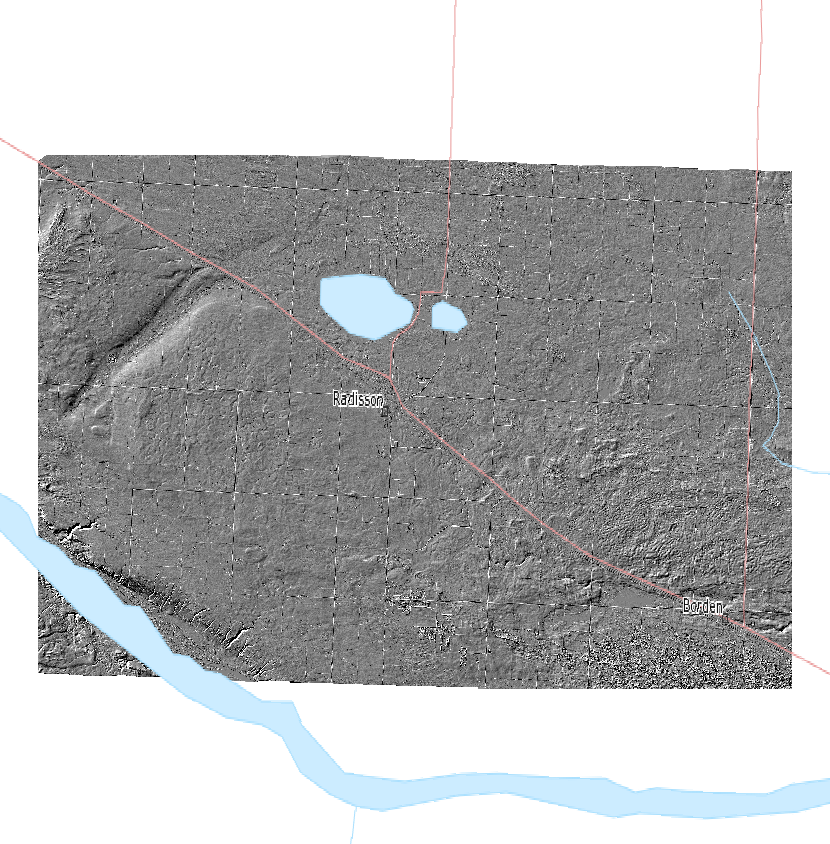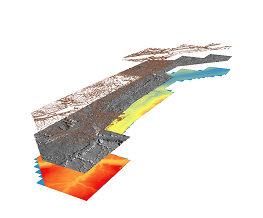Topographie
Type of resources
Available actions
Keywords
Contact for the resource
Provided by
Years
Formats
Representation types
Update frequencies
status
Service types
Scale
-

Digital Elevation Model (DEM) created from LiDAR data captured by McElhanney Consulting Services Ltd (MCSL). The DEM represent s the elevation of the landscape covered by this project.
-

LASer files of a subwatershed in the La Salle watershed, north of Elie, MB. The LiDAR data was collected using Fugro Horizons proprietary FLI-MAP Fx LiDAR system.
-

The AAFC Infrastructure Flood Mapping in Saskatchewan 1 meter Full Feature Hillshade is are the full feature hillshades created at a 1 m interval for the capture area of Saskatchewan. The full feature hillshade images were derived from the full feature DEM. The hillshades were created using a 315 degree sun azimuth and 45 degree sun angle.
-

The Agriculture and Agri-Food Canada’s LiDAR Projects dataset was created from existing spatial data. It contains the footprints (outlines) of all the LiDAR data that is openly distributed by Agriculture and Agri-Food Canada. LiDAR (Light Detection And Ranging) is a method of acquiring survey points using optical remote sensing technology. The dataset indicates basic information about the location, source and properties of the data.
-

LiDAR Services International (LSI), a Calgary-based LiDAR company completed an airborne LiDAR survey for the Redberry Lake Biosphere Reserve (RLBR) and Agriculture and Agri-Foods Canada (AAFC) in October 2011. The project involved collection of LiDAR data for a 362.97 km2 block area, 252.77 km2 for Redberry Lake and 110.20 km2 for AAFC northwest of Saskatoon, SK. Deliverables included: • 1 m bare earth and full feature grids in 1 km x 1 km tiles (ASCII XYZ format) • 1 m bare earth and full feature greyscale hillshades (GeoGeoTIF format) • Classified LiDAR point clouds and ASCII extractor program (LAS v1.2 format)
-

One meter hillshade generated from full feature DEM. LiDAR Services International (LSI), a Calgary-based LiDAR company completed an airborne LiDAR survey for the Redberry Lake Biosphere Reserve (RLBR) and Agriculture and Agri-Foods Canada (AAFC) in October 2011. The project involved collection of LiDAR data for a 362.97 km2 block area, 252.77 km2 for Redberry Lake and 110.20 km2 for AAFC northwest of Saskatoon, SK.
-

LiDAR data collected in the fall of 2011 and spring 2012 for AAFC owned water control structures in the Pheasant Creek, Roughbark, Moosomin,Braddock, Maple Creek, Eastend, Altawan, Admiral, Russell Creek, Cadillac-Gouveneur, Cypress, Middle Creek and Lafleche areas.
-

One meter digital elevation model generated from LiDAR point files. LiDAR Services International (LSI), a Calgary-based LiDAR company completed an airborne LiDAR survey for the Redberry Lake Biosphere Reserve (RLBR) and Agriculture and Agri-Foods Canada (AAFC) in October 2011. The project involved collection of LiDAR data for a 362.97 km2 block area, 252.77 km2 for Redberry Lake and 110.20 km2 for AAFC northwest of Saskatoon, SK.
-

The AAFC Infrastructure Flood Mapping in Saskatchewan 1 meter Bare Earth DEM are the bare earth DEMs created at a 1 m interval for the capture area of Saskatchewan. The bare earth DEM elevations were derived from a TIN surface model of the combined DTM Key Point and Ground classes in the LiDAR point cloud tiles. It should be noted that the grid point elevations have been interpolated from the LiDAR points and may contain greater uncertainty depending on the amount of interpolation performed.
-

The AAFC Infrastructure Flood Mapping in Saskatchewan 1 meter Bare Earth Hillshade is are the bare earth hillshades created at a 1 m interval for the capture area of Saskatchewan. The bare earth hillshade images were derived from the bare earth DEM. The hillshades were created using a 315 degree sun azimuth and 45 degree sun angle.
 Arctic SDI catalogue
Arctic SDI catalogue